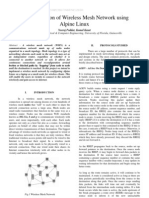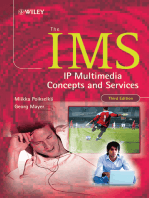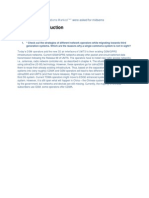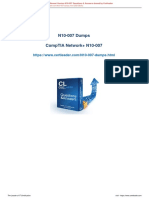Wireless Communication Introduction
Uploaded by
sanjeevsoni64Wireless Communication Introduction
Uploaded by
sanjeevsoni64Wireless Communications
Introduction to Wireless
Communications
Wireless Communications
Suggested Reading
1. T.S. Rappaport, Wireless Communications,
2nd Edition, Pearson Education. 2002.
2. W.C.Y. Lee, Mobile Cellular
Telecommunications, 2nd Edition, McGraw
Hill, 1995.
3. Kamilo Feher, Wireless Digital
Communications: Modulation and Spread
Spectrum Applications, Prentice Hall, 2002.
2
Wireless Communications
Wireless Communications
Module 1
Introduction
Wireless Communications
Outline of Module 1
What is Wireless Communications?
History of Wireless Communications
The advantages
The challenges
The types
The Indian factor
Wireless Communications
What is Wireless Communication?
Transmitting/receiving voice and data
using electromagnetic waves in open
space
The information from sender to receiver is carrier
over a well-defined frequency band (channel)
Each channel has a fixed frequency bandwidth and
Capacity (bit-rate)
Different channels can be used to transmit
information in parallel and independently.
5
Wireless Communications
Example
Assume a spectrum of 120 KHz is
allocated over a base frequency for
communication between stations A and B
Each channel occupies 40 KHz
Channel 1 (b - b+40)
Station A
Channel 2 (b+40 - b+80)
Channel 3 (b+80 - b+120)
Station B
Wireless Communications
Types of Wireless
Communication
Mobile
Cellular Phones (GSM / CDMA 2000.1x)
Portable
IEEE 802.11b (WiFi),
IEEE 802.15.3 (UWB) (Ultra Wide Band)
Fixed
IEEE 802.16 (Wireless MAN)
7
Wireless Communications
Typical Frequencies
FM Radio
TV Broadcast
GSM Phones
GPS
PCS Phones
Bluetooth
WiFi
~ 88 MHz
~ 200 MHz
~ 900 MHz
~ 1.2 GHz
~ 1.8 GHz
~ 2.4 GHz
~ 2.4 GHz
8
Wireless Communications
LF
30kHz
10km
MF
300kHz
1km
di
o
TV
ce
llu
l
TV
ar
ra
FM
AM
S/
W
ra
d
ra
d
io
io
The Electromagnetic
Spectrum
VHF
HF
3MHz
30MHz
100m
10m
UHF
300MHz
SHF
3GHz
EHF
30GHz
300GHz
1cm
100mm
10cm
1m
EHF - Extreme High Frequency
SHF - Super High Frequency
UHF - Ultra High Frequency
VHF - Very High Frequency
HF - High Frequency
MF - Medium Frequency
LF - Low Frequency
VLF - Very Low Frequency
X rays
infrared visible UV
1 kHz
1 MHz
1 GHz
1 THz
1 PHz
Gamma rays
1 EHz
Propagation characteristics are different in each frequency band
9
Wireless Communications
James Clerk Maxwell (18311879)
Scottish, Professor of physics, Kings College (London) and
Cambridge University. Formulated the theory of
electromagnetism from 1865 to 1873.
B
E
t
H J
D
B 0
D
t
His work established the theoretical foundation for the
development of wireless communications.
"From a very long view of the history of mankind - seen from, say, ten thousand years from now - there
can be little doubt that the most significant event of the 19th century will be judged as Maxwell's
discovery of the laws of electrodynamics. The American Civil War will fade into provincial
insignificance in comparison with this important scientific event of the same decade. "
Richard Feynman, Lectures on Physics, Vol. II
10
Wireless Communications
Timeline of Wireless Communications Development . . .
Dave interviews
at Bell Labs for
Mobile Phone
project This
thing isnt going
anywhere.
Prof. H. Hertz (18571894) experimental
validation of Maxwell
1886-1888 at
Karlsruhe
Guglielmo Marconi
(1874-1937)
development of
wireless telegraphy
trans-Atlantic 1901
2003 - US
cellular
subscribers
exceed 150M
Martin Cooper,
Motorola, develops
first handheld cellular
phone in 1973
1920
1860
1880
1900
1940
KDKA Radio -1920
Prof. J. Maxwell
(1831-1879) theory
of
electromagnetism
developed in 1865
1960
1980
Two-way mobile
radio services
1960s 1970s
First television
broadcast
-1928
11
2000
2004 - Indian
cellular
subscribers
exceed 45M
1983 - Cellular
AMPS service
in Chicago
Wireless Communications
Why Wireless Communication?
Freedom from wires
No cost of installing wires or rewiring
No bunches of wires running here and there
Auto magical instantaneous communications without
physical connection setup, e.g., Bluetooth, WiFi
Global Coverage
Communications can reach where wiring is infeasible
or costly, e.g., rural areas, old buildings, battlefield,
vehicles, outer space (through Communication
Satellites)
12
(1)
Wireless Communications
Why Wireless Communication? (2)
Stay Connected
Roaming allows flexibility to stay connected
anywhere and any time
Rapidly growing market attests to public need for
mobility and uninterrupted access
Flexibility
Services reach you wherever you go (Mobility). E.g,
you dont have to go to your lab to check your mail
Connect to multiple devices simultaneously (no
physical connection required)
13
Wireless Communications
Why Wireless Communication? (3)
Increasing dependence on
telecommunication services for business
and personal reasons
Consumers and businesses are willing to
pay for it
Basic Mantra: Stay connected
anywhere, anytime.
14
Wireless Communications
Challenges (1)
Efficient Hardware
Low power Transmitters, Receivers
Low Power Signal Processing Tools
Efficient use of finite radio spectrum
Cellular frequency reuse, medium access control
protocols,...
Integrated services
voice, data, multimedia over a single network
service differentiation, priorities, resource sharing,...
15
Wireless Communications
Multimedia Requirements
Voice
Data
Video
Delay
<100ms
<100ms
Packet Loss
BER
<1%
10-3
0
10-6
<1%
10-6
Data Rate
8-32 Kbps
Continuous
1-100 Mbps
Bursty
Traffic
1-20 Mbps
Continuous
One-size-fits-all protocols and design do not work well
Wired networks use this approach, with poor results
16
Wireless Communications
Challenges (2)
Network support for user mobility (mobile
scenarios)
location identification, handover,...
Maintaining quality of service over
unreliable links
Connectivity and coverage
(internetworking)
Cost efficiency
17
Wireless Communications
Challenges (3)
Fading
Multipath
Higher probability of data corruption
Hence, need for stronger channel codes
Need for stronger Security mechanisms
privacy, authentication,
18
Wireless Communications
Wireless vs Mobile
NOTE : Wireless does not necessarily
mean mobile
Wireless Systems may be
Fixed (e.g., Metropolitan Area Network)
Portable (e.g., wireless interaction between TV
and VCR)
Mobile (e.g., mobile phone)
19
Wireless Communications
Types of Wireless Communication (1)
Radio Transmission
Easily generated, omni-directionally travel long
distances, easily penetrate buildings
Problems:
frequency-dependent
relative low bandwidth for data communication
tightly licensed by the governments
Microwave Transmission
Widely used for long distance communication
Gives a high S/N ratio, relatively inexpensive
Problems:
dont pass through buildings well
weather and frequency-dependent
20
Wireless Communications
Types of Wireless Communication (2)
Infrared and Millimeter Waves
Widely used for short-range communication
Unable to pass through solid objects
Used for indoor wireless LANs, not for outdoors
Lightwave Transmission
Unguided optical signal, such as laser
Connect two LANs in two buildings via laser
mounted on their roof
Unidirectional, easy to install, dont require license
Problems:
unable to penetrate rain or thick fog
laser beam can be easily diverted by turbulent air
21
Wireless Communications
Wireless Systems : Range Comparison
1m
IR
10 m
100 m
Bluetooth
1 Km
WLANs
10 Km
100 Km
1,000 Km
Mobile
MW SW
Satellite
FM
Telephony, Radio Radio Radio Links
WLL
22
Wireless Communications
Growth : Technology take-up time to
50M users
Telephone
75 years
Radio
35 years
TV
13 years
Wireless Communications
12 years
Mobile Phones in India
10 years
Internet
4 years
23
Wireless Communications
User Growth
1,000
Fixed access
M illion subscribers
800
600
Mobile access
400
200
Fixed and
mobile Internet
Mobile Internet
1996
1998
2000
24
2002
2004
Wireless Communications
Traffic Growth
Traffic
150
Internet access
125
100
75
Voice
50
25
0
1998
1999
2000
25
2001
Wireless Communications
The Indian Affordability factor (1)
India has > 1 billion people and 180 million
households
Today, India has more mobile phones (~ 50 million)
than fixed line phones (~ 45 million)
Landline Phones:
Cost Rs 30,000 to install per line
Monthly revenue should be Rs. 1,000 for
economic viability.
Not affordable by more than 3% of the households
unless we have a cheap solution!
Need to go wireless in order to increase
tele-density.
26
Wireless Communications
The Indian Affordability factor (2)
India's mobile-phone industry is adding about 1.5
million new users a month (mostly in the cities).
The Telecom Regulatory Authority of India (TRAI)
predicts that there will be 150 million mobile
subscribers by 2007.
Declining prices for mobile-phone handsets will
likely keep sales rising into the future.
Mobile handset costs could drop to around Rs.
1,500 from Rs. 2,500, if local companies start to
manufacture the handsets.
27
Wireless Communications
The Indian Affordability factor (3)
Because of India's large geography, wireless is the
fastest and cheapest way to expand telecom
networks.
A large cellular subscriber base will give telecom
carriers the economies of scale to run sustainable
businesses.
The next big milestone in the Indian
telecommunications industry is the broadband
connectivity.
According to TRAI, India's broadband penetration
rate today is a negligible 0.02%.
The government aims to have 5 million broadband
users by 2007.
28
Wireless Communications
A Simplified Wireless Communication
System Representation
Antenna
Information to
be transmitted
(Voice/Data)
Coding
Modulator
Power
Amplifier
Carrier
Information
received
(Voice/Data)
Decoding
Demodulator
Carrier
29
Antenna
LNA
Wireless Communications
Summary of Lecture 1
What is Wireless Communications
A brief history of Wireless
Communications
The advantages and the challenges
The various types of Wireless
Communications
The Indian Affordability factor
30
Wireless Communications
End of Module 1
31
Wireless Communications
Wireless Communications
Module 2
Introduction to Current
Wireless Systems
32
Wireless Communications
Outline of Module 2
Existing Wireless Systems
Emerging Wireless Systems
Spectrum Regulations and Standards
Bodies
33
Wireless Communications
Current Wireless Systems
Cellular Systems
Wireless LANs
Satellite Systems
Paging Systems
Wireless PANs (bluetooth, UWB)
34
Wireless Communications
1. Cellular Systems
Reuse channels to maximize capacity
Geographic region divided into cells
Frequencies/timeslots/codes reused at spatiallyseparated locations
Base stations/Mobile Telephone Switching Offices
(MTSOs) coordinate handoff and control functions
BASE
STATION
MTSO
Wireless Communications
2. Wireless Local Area Networks (WLANs)
01011011
0101
1011
Internet
Access
Point
WLANs connect local computers
(100m range <= confined regions)
Breaks data into packets
Channel access is shared (random access)
Backbone Internet provides best-effort service
Poor performance in some applications (e.g. video)
Low mobility
36
Wireless Communications
Wireless LAN Standards
Bit rate
Frequency
Band
Range
IEEE 802.11b
5.5 11Mbps
2.4 GHz
~100m
IEEE 802.11a
54 Mbps
5 Ghz
~100m
HiperLAN
(Europe)
20Mbps
5 GHz
~50m
HiperLAN/2
54 Mbps
5 GHz
~50m
37
Wireless Communications
3. Satellite Systems (1)
Cover very large areas (global coverage)
Very useful in sparsely populated areas: rural areas, sea,
mountains, etc.
Different orbit heights
GEOs (36000 Km) versus LEOs (2000 Km)
Optimized for one-way transmission
Radio (XM, DAB) and movie (SatTV) broadcasting
Expensive base stations (satellites)
38
Wireless Communications
3. Satellite Systems (2)
Limited-quality voice/data transmission
Traditional Applications
Weather satellite
Radio and TV broadcasting
Military satellites
Telecommunication Applications
Global telephone connections
Backbone for global network
GPS
Intelsat, Globalstar, Teledesic, Inmarsat are some
example systems
39
Wireless Communications
4. Paging Systems
Broad coverage for short messaging
Message broadcast from all base stations
Simple terminals
Low complexity, very low-power pager (receiver)
devices
Optimized for 1-way transmission
Answer-back hard
Overtaken by cellular
40
Wireless Communications
Wide-Area Paging System
Terrestrial Link
City 1
Paging
Terminal
B a s e s ta tio n
T e le p h o n e
City 2
Terrestrial Link
PSTN
Paging Control
Center
Paging
Terminal
B a s e s ta tio n
S a t e llit e
City N
Paging
Terminal
Satellite Link
41
B a s e s ta tio n
pager
Wireless Communications
5. Personal Area Networks (PANs)
Bluetooth
Cable replacement RF technology (low cost)
Short range (10m, extendable to 100m)
2.4 GHz band (crowded)
1 Data (700 Kbps) and 3 voice channels
1 Mbps data rate shared between 7 devices
TDD duplex scheme
Polling based multiple access
Widely supported by telecommunications, PC, and
consumer electronics companies
8C32810.61-Cimini-7/98
Wireless Communications
5. PANs (2)
Example of a PAN as provided by the Bluetooth standard.
(Source : T. S. Rappaport, Figure 2.17)
43
Wireless Communications
Emerging Wireless Systems
Ad hoc wireless networks
Sensor networks
Distributed control networks
Ultra Wideband (UWB) Systems
44
Wireless Communications
1. Ad-Hoc Networks (1)
Peer-to-peer communications.
No backbone infrastructure.
Routing can be multihop.
Topology is dynamic.
Fully connected with different link SINRs
45
Wireless Communications
1. Ad-Hoc Networks (2)
Ad-hoc networks provide a flexible network
infrastructure for many emerging applications.
The capacity of such networks is generally unknown.
Transmission, access, and routing strategies for these
networks are generally ad-hoc.
Cross layer design critical and very challenging.
Energy constraints impose interesting design tradeoffs
for communication and networking.
46
Wireless Communications
2. Sensor Networks
Energy is the driving constraint
Nodes powered by non-rechargeable batteries
Data flows to centralized location.
Low per-node rates but up to 100,000 nodes.
Data highly correlated in time and space.
Nodes can cooperate in transmission, reception,
compression, and signal processing.
47
Wireless Communications
Distributed Control over Wireless Links. 3
Automated Vehicles
- Cars
- UAVs
- Insect flyers
Packet loss and/or delays impacts controller performance.
Controller design should be robust to network faults.
Joint application and communication network design.
48
Wireless Communications
4. Ultra Wide Band Systems (1)
Ultra Wide Band (UWB) is an emerging wireless
communications technology that can transmit data at
around 100 Mb/s (up to 1000 Mb/s).
UWB transmits ultra-low power radio signals with
very narrow pulses (nanosecond).
Because of its low power requirements, UWB is very
difficult to detect (hence secure).
ns
A typical UWB pulse
49
Wireless Communications
4. Ultra Wide Band Systems (2)
50
Wireless Communications
4. Ultra Wide Band Systems (3)
Why UWB?
Exceptional multi-path immunity
Low power consumption
Large bandwidth
Secure Communications
Low interference
No need for a license to operate
Next generation communication system
51
Wireless Communications
4. Ultra Wide Band Systems (4)
Home
entertainment
UWB PAN
Wearable
computing
52
Wireless
desktop
Wireless Communications
Spectrum Regulation
Worldwide spectrum controlled by ITU-R
ITU auctions spectral blocks for set applications.
Some spectrum set aside for universal use.
Spectral allocation/regulation heavily impacts the evolution
of wireless technology
53
Wireless Communications
Standard Bodies
CCIR(Consultative Committee on
International Radio)
study groups for radio spectrum usage and
interworking of wireless systems
Radio Communications Sector ITU-R
(formerly CCIR and IFRB)
world conferences, radio regulations
Telecommunication Standardization Sector
ITU-T (formerly CCITT)
all worldwide wireline and wireless standards
IEEE standards often accepted
54
Wireless Communications
Summary of Module 2
Existing Wireless Systems
Emerging Wireless Systems
Spectrum Regulations and Standards
Bodies
55
Wireless Communications
End of Module 2
56
You might also like
- Design High Speed, Low Noise, Low Power Two Stage CMOSNo ratings yetDesign High Speed, Low Noise, Low Power Two Stage CMOS5 pages
- INFO-3138 Tutorial 7 - DOM Node, NodeList, NamedNodeMapNo ratings yetINFO-3138 Tutorial 7 - DOM Node, NodeList, NamedNodeMap5 pages
- Wireless Network: Types of Wireless NetworksNo ratings yetWireless Network: Types of Wireless Networks5 pages
- Common Properties of Control: Form ControlsNo ratings yetCommon Properties of Control: Form Controls48 pages
- Unit 1 Introduction To WML and WAP: StructureNo ratings yetUnit 1 Introduction To WML and WAP: Structure17 pages
- CS-306 Computer Networks: Today's Topics Wireless LAN IEEE 802.11 LAN'S Wimax BluetoothNo ratings yetCS-306 Computer Networks: Today's Topics Wireless LAN IEEE 802.11 LAN'S Wimax Bluetooth10 pages
- Module 5 RTOS and IDE For Embedded System DesignNo ratings yetModule 5 RTOS and IDE For Embedded System Design235 pages
- CNE Tutorial 02 - Real - LAN and LAN With Packet TracerNo ratings yetCNE Tutorial 02 - Real - LAN and LAN With Packet Tracer18 pages
- Computer Networks: by Damera Venkatesh Assistant ProfessorNo ratings yetComputer Networks: by Damera Venkatesh Assistant Professor22 pages
- NGN Components/Elements and Their Description: PTCL Training & Development100% (1)NGN Components/Elements and Their Description: PTCL Training & Development3 pages
- Mobile Computing: Introduction:: Unit - INo ratings yetMobile Computing: Introduction:: Unit - I4 pages
- Computer Networking - PPTX TYpes of NetworksNo ratings yetComputer Networking - PPTX TYpes of Networks9 pages
- Internet and Web Technology B.E. 6th Sem I.T.No ratings yetInternet and Web Technology B.E. 6th Sem I.T.203 pages
- Notes For Unit 5 Mobile Computing ArchitectureNo ratings yetNotes For Unit 5 Mobile Computing Architecture29 pages
- Remote Procedure Call in Distributed SystemNo ratings yetRemote Procedure Call in Distributed System26 pages
- Raiganj University: "Network Topologies With Reference To LAN"No ratings yetRaiganj University: "Network Topologies With Reference To LAN"8 pages
- OUTCOME 1 and 2 Data Structure and AlgorithmNo ratings yetOUTCOME 1 and 2 Data Structure and Algorithm108 pages
- Digital Image Processing: Lab 2: Image Enhancement in The Spatial Domain100% (1)Digital Image Processing: Lab 2: Image Enhancement in The Spatial Domain16 pages
- Operating System Support in Distributed SystemsNo ratings yetOperating System Support in Distributed Systems4 pages
- MESFET Distributed Amplifier Design GuidelinesNo ratings yetMESFET Distributed Amplifier Design Guidelines8 pages
- CMOS Logic Circuit Design: Combinational and Sequential CMOS CircuitsNo ratings yetCMOS Logic Circuit Design: Combinational and Sequential CMOS Circuits19 pages
- Electron Spin and Its History - Eugene D. ComminsNo ratings yetElectron Spin and Its History - Eugene D. Commins27 pages
- Tai - Pereira - An Approximate Formula For Calculating The Directivity of An AntennaNo ratings yetTai - Pereira - An Approximate Formula For Calculating The Directivity of An Antenna2 pages
- Mathemtical - Methods - Niels Walet PDFNo ratings yetMathemtical - Methods - Niels Walet PDF76 pages
- Design of Millimeter-Wave Wideband Mixerwith A Novel If Block - M. Z. ZhanNo ratings yetDesign of Millimeter-Wave Wideband Mixerwith A Novel If Block - M. Z. Zhan12 pages
- An Ultra-Low Power CMOS LNA For WPAN Applications: Hang-Ji Liu and Zhao-Feng ZhangNo ratings yetAn Ultra-Low Power CMOS LNA For WPAN Applications: Hang-Ji Liu and Zhao-Feng Zhang3 pages
- A Study and Analysis of Two Stage Single Ended CMOS OP-AMPNo ratings yetA Study and Analysis of Two Stage Single Ended CMOS OP-AMP9 pages
- Graphene-Based Nano-Antennas For Electromagnetic Nanocommunications in The Terahertz Band PDFNo ratings yetGraphene-Based Nano-Antennas For Electromagnetic Nanocommunications in The Terahertz Band PDF5 pages
- User Manual: Wireless AC750 Dual Band RouterNo ratings yetUser Manual: Wireless AC750 Dual Band Router101 pages
- Energy Management System in Adhoc Wireless Networks: Gantinagasatish, Prof.P.Suresh VarmaNo ratings yetEnergy Management System in Adhoc Wireless Networks: Gantinagasatish, Prof.P.Suresh Varma3 pages
- Design and Implementation of IEEE 802.11i in WIRE1xNo ratings yetDesign and Implementation of IEEE 802.11i in WIRE1x19 pages
- BM626 WiMAX CPE Online Help (V100R001 - 05, Basic)No ratings yetBM626 WiMAX CPE Online Help (V100R001 - 05, Basic)33 pages
- TP configuration de base des WLAN avec le contrôleur WLCNo ratings yetTP configuration de base des WLAN avec le contrôleur WLC9 pages
- SonicWALL NSA 5000 4500 3500 Getting Started GuideNo ratings yetSonicWALL NSA 5000 4500 3500 Getting Started Guide62 pages
- Design High Speed, Low Noise, Low Power Two Stage CMOSDesign High Speed, Low Noise, Low Power Two Stage CMOS
- INFO-3138 Tutorial 7 - DOM Node, NodeList, NamedNodeMapINFO-3138 Tutorial 7 - DOM Node, NodeList, NamedNodeMap
- CS-306 Computer Networks: Today's Topics Wireless LAN IEEE 802.11 LAN'S Wimax BluetoothCS-306 Computer Networks: Today's Topics Wireless LAN IEEE 802.11 LAN'S Wimax Bluetooth
- CNE Tutorial 02 - Real - LAN and LAN With Packet TracerCNE Tutorial 02 - Real - LAN and LAN With Packet Tracer
- Computer Networks: by Damera Venkatesh Assistant ProfessorComputer Networks: by Damera Venkatesh Assistant Professor
- NGN Components/Elements and Their Description: PTCL Training & DevelopmentNGN Components/Elements and Their Description: PTCL Training & Development
- Raiganj University: "Network Topologies With Reference To LAN"Raiganj University: "Network Topologies With Reference To LAN"
- The IMS: IP Multimedia Concepts and ServicesFrom EverandThe IMS: IP Multimedia Concepts and Services
- Digital Image Processing: Lab 2: Image Enhancement in The Spatial DomainDigital Image Processing: Lab 2: Image Enhancement in The Spatial Domain
- CMOS Logic Circuit Design: Combinational and Sequential CMOS CircuitsCMOS Logic Circuit Design: Combinational and Sequential CMOS Circuits
- Tai - Pereira - An Approximate Formula For Calculating The Directivity of An AntennaTai - Pereira - An Approximate Formula For Calculating The Directivity of An Antenna
- Design of Millimeter-Wave Wideband Mixerwith A Novel If Block - M. Z. ZhanDesign of Millimeter-Wave Wideband Mixerwith A Novel If Block - M. Z. Zhan
- An Ultra-Low Power CMOS LNA For WPAN Applications: Hang-Ji Liu and Zhao-Feng ZhangAn Ultra-Low Power CMOS LNA For WPAN Applications: Hang-Ji Liu and Zhao-Feng Zhang
- A Study and Analysis of Two Stage Single Ended CMOS OP-AMPA Study and Analysis of Two Stage Single Ended CMOS OP-AMP
- Graphene-Based Nano-Antennas For Electromagnetic Nanocommunications in The Terahertz Band PDFGraphene-Based Nano-Antennas For Electromagnetic Nanocommunications in The Terahertz Band PDF
- Energy Management System in Adhoc Wireless Networks: Gantinagasatish, Prof.P.Suresh VarmaEnergy Management System in Adhoc Wireless Networks: Gantinagasatish, Prof.P.Suresh Varma
- Design and Implementation of IEEE 802.11i in WIRE1xDesign and Implementation of IEEE 802.11i in WIRE1x
- BM626 WiMAX CPE Online Help (V100R001 - 05, Basic)BM626 WiMAX CPE Online Help (V100R001 - 05, Basic)
- TP configuration de base des WLAN avec le contrôleur WLCTP configuration de base des WLAN avec le contrôleur WLC
- SonicWALL NSA 5000 4500 3500 Getting Started GuideSonicWALL NSA 5000 4500 3500 Getting Started Guide








































































































